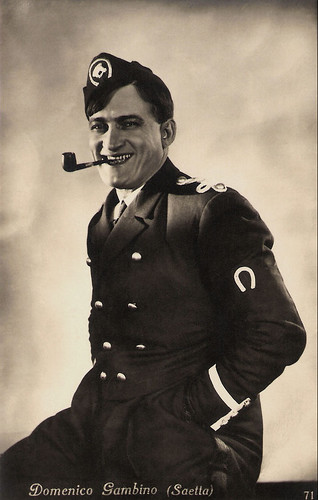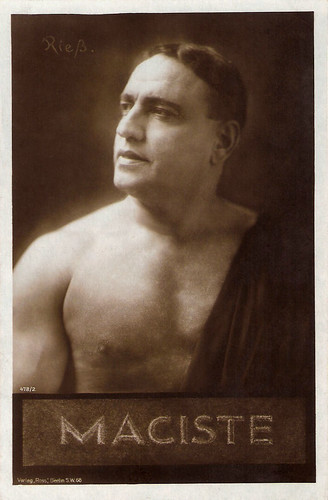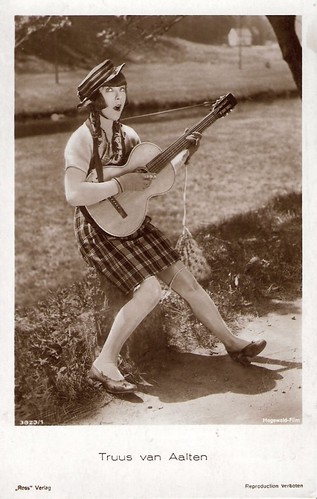
Italian postcard by Ed. A. Traldi, Milano, no. 71. Photo: publicity still for Caporal Saetta (1924, Eugenio Perego).
Stuntman and Crossdresser
Domenico Maria Gambino was born in Turin, Italy in 1891, and came from a family of pastry bakers. At a young age, he ran away from home and joined a circus but his dad brought him back. He then passed on to the stage where he became part of a company by Enrico Gemelli, performing in dialect.
According to Vittorio Martinelli, one day in 1908 he saw a location shooting by the Itala film company. He noticed an actor who had fallen from a coach but was not eager to repeat this stunt. Gambino offered to replace him.
True or not, in 1909 Gambino was hired by the rival company of Pasquali to star in the title role in the historical film Ettore Fieramosca – La disfida di Barletta (Ernesto Maria Pasquali, 1909). The film had spectacular battle scenes and a final scene with Gambino jumping from a rock with his horse, but the film wasn’t a big success though.
Between 1910 and 1916 Gambino worked for the Itala company, appearing as an extra in the comedies with Cretinetti (André Deed) and in other comedies, often dressing up as a woman. In 1911 he started his own comic Saltarelli series, starting with Saltarelli ha fatto bagno nel caucciù (1911), followed by Vista corta, ma testa dura (1912). In his book Maciste & Co., Martinelli also mentions Saltarelli e l’ascensore and Saltarelli ladro per forza, but these are lacking in the Bernardini/Martinelli reference books.
In 1912 Gambino returned to the stage as a ‘young actor’ in the dialectic company of Carlo Nunziata. The following year, he was again hired by Itala as actor and stuntman in the comedy L’attrice burlona/The Prankster Actress (Mario Morais, 1913) with Ernesto Vaser, and the comedy Più forte che Sherlock Holmes/Stronger than Sherlock Holmes (Giovanni Pastrone, 1913) with Emilio Vardannes aka Totò, the latter film with ingenious special effects by Segundo De Chomon.
In 1914 Gambino appeared in the cast of the historical epic Cabiria (Giovanni Pastrone, 1914), starring Lydia Quaranta, Umberto Mozzato, Bartolomeo Pagano and Italia Almirante.
In 1915 he had a supporting part in André Deed’s La paura degli aeromobili nemici/The fear of the enemy aircraft (André Deed, 1915). In 1915 Gambino returned to Pasquali for a supporting part in a remake of Ettore Fieramosca (Umberto Paradisi, 1915), this time with Giovanni Cimara in the title role, and for a leading part as a heroic athlete in an adventure film by scenographer-turned-director Domenico Gaido: Mascherata in mare/The Avenging Acrobat (1917-1918) starring Henriette Bonard.
Apparently, the tide was turning for Gambino, as in the same year he moved to Ambrosio and directed his first film: La spirale della morte/The Death Leap (Filippo Castamagna, Domenico Gambino, 1917-1918), starring Luciano Albertini and Cecyl Tryan, and with Bonard and Gambino in supporting parts. It dealt with a marine officer who, with the help of circus artists, fights an enemy navy. The film was well-received by the press. In those years Gambino was a jack-of-all-trades at Itala, worked as assistant-director for Pastrone as well, and supposedly pointed him out Bartolomeo Pagano, who would become famous as Maciste.

Bartolomeo Pagano alias Maciste. German postcard by Ross Verlag, no. 478/2, 1919-1924. Photo: Riess.
A New Comic Character
In 1918 Domenico Gambino founded his own film company, Delta Film, and started interpreting a new comic character, named Saetta by his regular scriptwriter Fantasio (Riccardo Artuffo). Saetta protected the good people against the evil ones, often helped by his animals (dogs, monkeys, etc.)
As a true acrobat, he was specialised in climbing facades and doing daredevil jumps, meticulously preparing his stunts. Despite the crisis in Italian cinema in the 1920s, Gambino managed to make several films each year. In 1919 he directed and starred as Saetta in Un demone gli disse…/A demon said ... (Domenico Gambino, 1919), after that he left directing to Ettore Ridoni in Il salto della morte/Salto Mortale (1919-1920) and I tre vagabondi/The Three Vagabonds (1919-1920).
By now the character was so popular that Gambino made a film simply called Saetta (Ettore Ridoni, 1920), followed by Saetta salva la regina/Saetta Saves the Queen (Ettore Ridoni, 1920). After that Gambino retook directing in Il sotterraneo fatale/The Fatal Underground (Domenico Gambino, 1921) and Saetta contro G1921-1922, olia/Saetta Versus Goliath (Domenico Gambino, Michele Malerba, 1920-1921), the latter for Albertini-Film.
Eventually, Saetta was a name Gambino also gave to his film company, altered in Saetta Film. Here he made Saetta e il club dei ciuffi/Saetta and the club of the tufts (Domenico Gambino, Mario Roncoroni, 1921), Saetta contro l’orco di Marcouff/Saetta Against the Ogre Marcouff (Domenico Gambino, Michele Malerba, 1921), and Saetta più forte di Sherlock Holmes/Saetta, Stronger Than Sherlock Holmes (Domenico Gambino, Mario Roncoroni, 1921-1922).
Often Pina Majelli was the love interest of Saetta in these films. While in 1922 he was momentarily away, he returned in 1923 with Il capolavoro di Saetta/Saetta's masterpiece (Eugenio Perego, 1923), Saetta contro la ghigliottina/Saetta Against the guillotine (Emilio Vardannes, 1923), I millioni di Saetta/The Millions of Saetta (Ubaldo Pittei, 1923), and Saetta impara a vivere/Saetta Learns To Live (Guido Brignone, 1924).
He was Maciste’s sidekick in Maciste imperatore/Emperor Maciste (1924), then continued with Caporal Saetta/Corporal Saetta (Eugenio Perego, 1924), and Saetta principe per un giorno/Saetta Prince for a day (Mario Camerini, 1924). Until 1925 Gambino interpreted the prosperous series of Saetta, the last ones being Saetta e le sette mogli del Pascià/Saetta and the seven wives of the Pasha (Luciano Doria, 1925) and Saetta Mefistofele/Saetta Mephistopheles (Domenico Gambino, 1925).

Truus van Aalten. German postcard by Ross Verlag, no. 3823/1, 1928-1929. Photo: Hegewald Film.
His Last Finest Hour
After this Gambino was supposed to shoot a film called Saetta fascista/Satta Fascist, but he refused and went abroad to Germany. There he shot a modest number of films between 1928 and 1935, starting with Die letzte Galavorstellung des Zirkus Wolfsohn/The last gala performance of the circus Wolfensohn (Domenico Gambino, 1928) starring Hermann Vallentin, followed by Diebe/Thieves (Domenico Gambino, Edmund Heuberger, 1928) with Wilhelm Dieterle.
He made the switch to German sound film even though he didn’t speak the language very well. These films were almost always done in co-direction with German filmmakers. He shot Ich hab’ mein Herz im Autobus verloren (Carlo Campogalliani, Domenico Gambino, 1929) with Truus van Aalten, Der Bergführer von Zakopane/The mountain guide of Zakopane (Domenico Gambino, Adolf Trotz, 1930), Dynamit/Dynamite (1932), and Meister Petz in Wintersport (1935).
Gambino also acted in a series of films with the character Billy, directed by Edmund Heuberger, plus some other films. He returned to Italy in 1935, but film boss Luigi Freddi hadn’t forgiven Gambino’s earlier refusal. So he became jobless for a year. He tried to return with a cheap film, Un bacio a fior d'acqua?/A kiss on the water surface (Giuseppe Guarino, 1936). This comedy tried to revamp his old glories as Saetta, but it flopped.
Between 1938 and 1941 Gambino managed to shoot some adventure films and cheap thrillers: Lotta nell’ombra/Battles in the Shadow (1939) with Antonio Centa, La traversata nera/The Black Crossing (1939) with Camillo Pilotto, Il segreto di Villa Paradiso/The Secret of Villa Paradiso (1940), La donna perduta/The Forgotten Woman (1941), and La pantera nera/The Black Panther (1942) starring Leda Gloria.
He had a last finest hour with Arditi civili/Fearless Firemen (Domenico Gambino, 1940), a film on the fire brigades. Leaving actors and firemen breathless, he did several daring stunts as a stand-in. After the war, Gambino still did a handful of film acting and directing before retiring. As an actor, he peaked in Abbasso la ricchezza!/Down with wealth! (Gennaro Righelli, 1948), opposite Anna Magnani and Vittorio De Sica as main actors.
His last film was La Luciana (1954, Domenico Gambino). Domenico Gambino died in 1968 in Rome at the age of 77.

Anna Magnani. French postcard by Editions P.I., Paris, no. 386.
Sources: Vittorio Martinelli (Maciste & Co), Aldo Bernardini/Vittorio Martinelli (Il cinema muto italiano), Wikipedia (Italian), and IMDb.
This post was last updated on 10 September 2021.
No comments:
Post a Comment